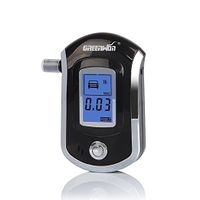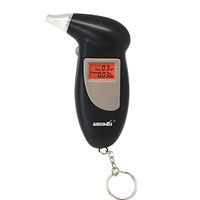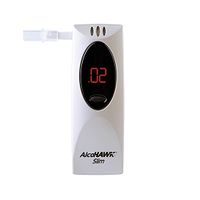Difference between revisions of "Breath Acetone Meters"
User:Fellrnr (User talk:Fellrnr | contribs) (Created page with "Acetone is produced when your body is burning fat, and this can be measured in your breath. There are now a growing number of options for measuring your breath acetone. The de...") |
(No difference)
|
Revision as of 11:39, 18 June 2017
Acetone is produced when your body is burning fat, and this can be measured in your breath. There are now a growing number of options for measuring your breath acetone. The devices vary wildly in price, and while some of the cheaper options may be problematic, they may still be worth considering. In all cases, how you breath when taking a measurement is critical to getting a consistent and accurate reading.
- The best option at the moment would appear to be Ketonix, which is designed specifically as a breath acetone meter. This is one of the more expensive devices, but if you want a degree of accuracy it's probably worthwhile.
- A cheap breathalyzer can be used as an improvised breath acetone meter. While these devices are intended to measure alcohol intoxication through breast measurement, the cheaper devices also detect acetone. This means you have to get a cheap, low quality breathalyzer, as the better devices will filter out any acetone.
- There's another dedicated breath acetone meter called Ketometer. It's cheaper than the Ketonix, but more expensive than a cheap breathalyzer.
- LEVL is a remarkably expensive device for measuring breath acetone, and it requires an ongoing subscription. At the time of writing, it's$699 + $49/month, which is too expensive for me to consider. One interesting note is that it comes with a calibration gas, something I've not seen with any other device. LEVL.
- There is a single use breath acetone test launched by Metron, but it's unclear if this is still available options. The cost of around $3/test makes it even more expensive than blood BOHB testing, which is generally considered the gold standard. Metron.
Contents
1 Ketonix
The Ketonix is designed to be a breath acetone meter, for use with the Ketogenic Diet. While it's designed specifically for acetone, the documentation does mention that it will pick up alcohol in your breath as well. A number of users have complained about inconsistent readings, but I suspect that's due to breathing patterns (see below.) The Ketonix is quite pricey, but may be worthwhile if you want accuracy. There are several generations of Ketonix:
- Original. The first generation glowed in three different colors to indicate your breath acetone level. While the original version connects via USB, it doesn't appear that there is any data transfer.
- Ketonix 2015. This generation that provides an acetone measure as a number between 0-100. The 2015 version was available in red or blue, each with a slightly different preloaded configuration.
- Ketonix 2016. With this update, the breath acetone level is given as PPM rather than an arbitrary number.
- Ketonix 2017. The latest version uses Bluetooth to connect to a smart phone app in addition to the earlier USB integration. There's an upgrade adapter for earlier versions to use Bluetooth.
I have a Ketonix on order, and will provide more details after I've tested. More at Ketonix.com.
2 Cheap Breathalyzers
A good quality breathalyzer will only measure breath alcohol content, screening out any acetone that's present. However, the cheaper breathalyzers that use a simple silicon sensor don't to distinguish between alcohol and acetone. This makes them an interesting option for checking breath ketones, and I've tested several different types. One obvious conclusion is that because you're buying a remarkably cheap device, quality is rather poor. I had one device that just gave random readings, even with the rebreathing technique mentioned below. I haven't yet been able to compare these cheap breathalyzers systematically to the Ketonix, but I found a reasonable correlation between their readings and blood ketone testing. Here are some suggested devices:
- Greenwon AT6000. This small handheld device shows Blood Alcohol Content (BAC) to three decimal places. That's nice to have, as BAC values I've measured are typically in the range 0 to 0.08, so the AT6000 provides two significant digits. If you're BAC value is above 0.05, it will be loudly and repeatedly to warn you that you're too drunk to drive. This is really annoying if you're stone cold sober. All these cheap breathalyzers have a warm-up period for their sensor, and the AT6000 counts down from 100, taking about 20 seconds. Error: Could not parse data from Amazon!.
- Greenwon Keyring. This is a smaller version of the AT6000, though the size difference isn't all that great. It only provides BAC values to two decimal places, and it warms up in 10 seconds. It's a little cheaper than the AT6000, and its beeps are really quiet, something that I appreciate. Error: Could not parse data from Amazon!.
- AlcoHAWK Slim. The shape of the AlcoHAWK works well for me, as it will slip into the pocket of my Race Ready Shorts, making it a little easier to use while out for a run. It only provides two decimal places, and a fairly soft beep. It has a long warmup time, and the warmup time is variable between 20 and 40 seconds, which is annoying. The mouthpiece folds down, which makes carrying easier. Error: Could not parse data from Amazon!.
2.1 BAC Values and Acetone Concentrations
It's unclear how to relate BAC values from a cheap breathalyzer to acetone concentrations in PPM. One rough estimate is to multiple BAC by 170, but if you've got more details, please let me know. To translate the idea that a one pound (0.5 Kg) per week fat loss correlated with 1.7 PPM of acetone, that would be a BAC of 0.01%. (That's on a non-Ketogenetic diet.)
3 Ketometer
The Ketometer is much cheaper than the Ketonix, but it has rather more of a prototype vibe to it. The Ketometer doesn't provide a PPM reading, just a relative value, and there's no software interface or indication of calibration. I think the price point for the Ketometer is a little wrong; if I'm willing to pay for the Ketometer, I'd rather pay a little more and get to the Ketonix. If I don't want the accuracy and software support of the Ketonix, then I'd stick with a cheap breathalyzer. More at ketometer.biz.
4 Breathing Patterns
Acetone is exchanged mostly in the airways, not the part of your lungs that exchange carbon dioxide and oxygen. This means that the way you breathe into a breath acetone meter will have a big impact on the acetone concentration in your breath:
- A normal, resting breath will result in only about two thirds the maximum acetone concentration.
- A full breath, breathing in deeply and fully exhaling will result in ~85% of maximum acetone concentration but only at the end of the breath. For cheap breathalyzers, they often don't measure the full breath.
- Breathing in and out of a bag for six breaths results in the maximum acetone concentration and the best repeatability. Of course, this is the most uncomfortable method.
- Breath holding, even for more than 60 seconds, has no impact on breath acetone concentration.
5 See Also
- The classifications and types of Low Carbohydrate Diet.
- An introduction to the Ketogenic Diet.
- My experiences with ultrarunning on the Ketogenic Diet
- My Ketogenic Recipes
- Non-Ketogenic Low Carbohydrate Diets


